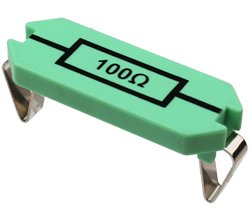Resistors ...... For mechanical and electrical engineers
Lamore ! Your favorite shopping site
In other words, it is a device or material that offers resistance to the free flow of electrons in an electric circuit. I am now going to relate it to ohms law to make it more understandable.
Ohms law states,
V = IR
Ohm is the unit of Resistance. It's reciprocal is Conductance.
Let's run through some examples to make you see its theoretical application.
Example 1
Find the resistance of a coil which draws current of 50mA from a 120V supply
Using formula,
V= IR
Making R subject of the formula
R = V/I
R = 120/50*10^-3
R = 2.4k ohms
V= IR
Making R subject of the formula
R = V/I
R = 120/50*10^-3
R = 2.4k ohms
Example 2
Find the resistance of a material with conductance of 0.02 ohm-1
Find the resistance of a material with conductance of 0.02 ohm-1
Remember conductance is the reciprocal of resistance
G=1/R
Now make R subject of formula. I am going to show you two methods of doing this:
1. Cross multiplication:
G =1/R
Cross multiply
GR = 1
Divide both sides by G
R=1/G
G=1/R
Now make R subject of formula. I am going to show you two methods of doing this:
1. Cross multiplication:
G =1/R
Cross multiply
GR = 1
Divide both sides by G
R=1/G
2. Inversion method
G=1/R
Invert both sides
1/G = R
G=1/R
Invert both sides
1/G = R
Therefore,
R = 1/G
R = 1/0.02
R = 50 ohms
R = 1/G
R = 1/0.02
R = 50 ohms
That's all for the post of today. In my next post, I will show you the different types of resistors there is and give credits to sites where photos were gotten from. I am also going to teach you all about colour coding.

You know about engineering?? You really are very good sir
Thanks so much dear